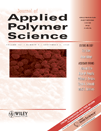Surface free energy analysis of poly(HEMA)-poly(perfluoroacrylate) copolymer networks
Abstract
Copolymer networks of 2-hydroxyethylmethacrylate (HEMA) and 2-(N-ethyl perfluorooctane sulfonamido)ethyl acrylate (FOSEA) were prepared by free-radical polymerization. Ethylene glycol dimethacrylate (EGDM) was used as crosslinker and 2,2′-azobisisobutyronitrile (AIBN) was used as radical initiator. HEMA/FOSEA ratio of the copolymer networks changed from 50/1 to 10/1 (mol/mol). The contact angles of water, ethylene glycol, glycerin, diiodomethane, paraffin, and formamide were measured on copolymer surfaces and results were evaluated in term of surface free energy components using van Oss–Good methodology. It was determined that the Lifshits–van der Waals component (γ ) and total surface tension (γ
) and total surface tension (γ ) of networks decreased drastically with the increase of the FOSEA content. However, the electron donor and acceptor components of the surface free energy did not differ that much. © 2006 Wiley Periodicals, Inc. J Appl Polym Sci 101: 3343–3347, 2006
) of networks decreased drastically with the increase of the FOSEA content. However, the electron donor and acceptor components of the surface free energy did not differ that much. © 2006 Wiley Periodicals, Inc. J Appl Polym Sci 101: 3343–3347, 2006




